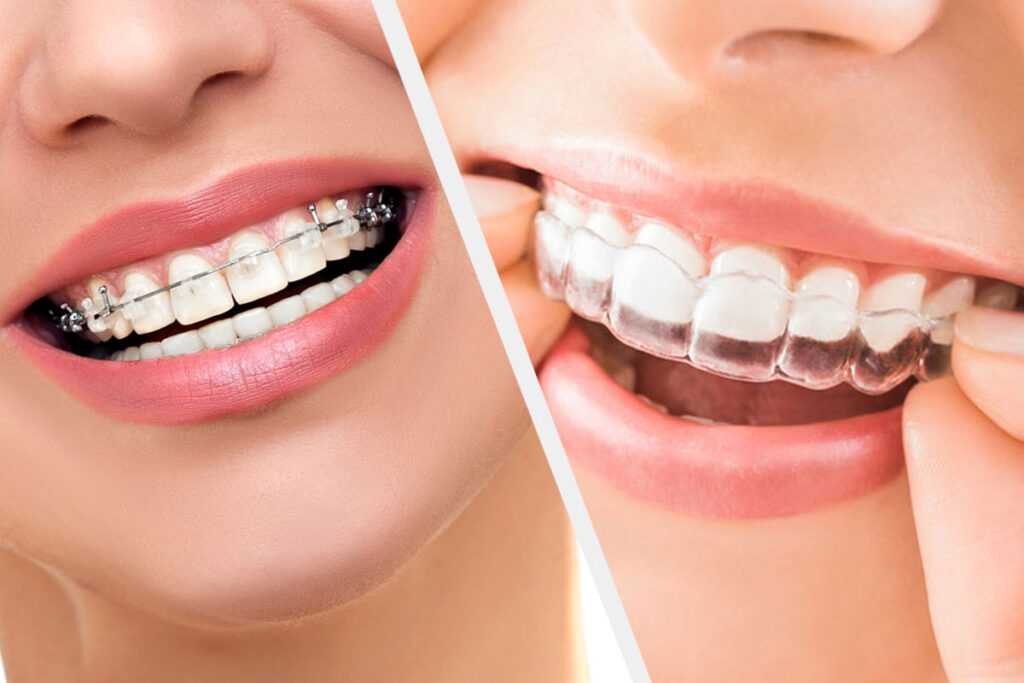The Modern Orthodontic Dilemma
For anyone considering orthodontic treatment, one of the biggest decisions is choosing between Invisalign and traditional braces. Both options effectively straighten teeth and improve bite alignment, but they differ in cost, comfort, maintenance, and overall experience. The question most patients ask is not only which works better—but which offers better value in the long run.
While braces have been around for decades, Invisalign’s clear aligner technology has redefined orthodontic treatment, particularly for adults and image-conscious teens. Understanding the real benefits and trade-offs—especially regarding Invisalign cost, effectiveness, and convenience—helps you make an informed choice that suits your lifestyle and budget.
Understanding How Each Treatment Works
Braces:
Traditional braces use metal or ceramic brackets attached to the teeth, connected by an archwire that applies constant pressure to gradually shift teeth into alignment. They’re highly effective for all levels of misalignment, including severe bite and jaw issues.
Invisalign:
Invisalign uses a series of custom-made, transparent aligners that fit snugly over your teeth. Each aligner is worn for about two weeks before switching to the next one in the series, slowly guiding teeth into their correct positions.
Both methods aim for the same end result—a healthy, straight smile—but the journey looks and feels different for each patient.
-
Effectiveness and Treatment Scope
When it comes to complex cases—severe crowding, rotations, or bite correction—traditional braces remain the gold standard. They provide orthodontists with full control over each tooth’s movement, making them ideal for patients who need significant adjustments.
Invisalign, on the other hand, is incredibly effective for mild to moderate alignment issues. With technological advancements like SmartTrack® material and precision attachments, Invisalign can now handle more complex cases than before, though it still has limitations compared to braces for major jaw corrections.
Verdict:
- Braces: Best for severe or complex orthodontic issues.
- Invisalign: Best for mild to moderate misalignment.
-
Aesthetics and Appearance
This is where Invisalign shines. Its clear, removable trays are virtually invisible, making it the preferred choice among adults and professionals who want to straighten their teeth discreetly.
Braces—whether metal or ceramic—are more visible, though modern designs are sleeker and less intrusive than in the past. Ceramic braces offer a middle ground: effective and less noticeable, though still not as subtle as Invisalign.
Verdict:
- Invisalign: Nearly invisible and aesthetically superior.
- Braces: Noticeable, though newer designs are more discreet than ever.
-
Comfort and Convenience
Invisalign aligners are smooth, with no brackets or wires to cause irritation. They can be removed during meals and brushing, which allows for easier oral hygiene and fewer food restrictions.
Braces, while effective, may cause occasional discomfort after adjustments and require avoiding sticky or hard foods to prevent damage. They also make brushing and flossing more time-consuming.
Verdict:
- Invisalign: More comfortable and easier to maintain.
- Braces: Require more adjustment and dietary caution.
-
Maintenance and Oral Hygiene
With braces, cleaning can be a challenge—plaque can easily build up around brackets if not brushed carefully. Special tools like interdental brushes or water flossers are often necessary to keep teeth clean.
Invisalign aligners simplify hygiene. You remove them to brush and floss normally, reducing the risk of staining or decay. However, aligners must be cleaned daily with lukewarm water and a mild cleanser to avoid odor or discoloration.
Verdict:
- Invisalign: Easier to clean and maintain oral hygiene.
- Braces: Require diligent cleaning routines.
-
Duration of Treatment
Treatment length varies depending on the complexity of each case. Braces typically take 18 to 30 months, while Invisalign averages 12 to 18 months for mild to moderate cases.
However, Invisalign’s effectiveness depends heavily on patient compliance—aligners must be worn 20–22 hours per day. Skipping wear time or losing trays can extend treatment duration.
Verdict:
- Invisalign: Faster for compliant patients with simpler cases.
- Braces: More consistent for complex corrections.
-
Cost Comparison and Overall Value
The Invisalign cost varies depending on the severity of your case, treatment duration, and region. On average, Invisalign ranges from $4,000 to $8,000, while traditional braces typically fall between $3,000 and $7,000.
Although Invisalign may cost slightly more upfront, its flexibility, comfort, and aesthetic benefits can make it a better long-term value for many patients. Moreover, fewer emergency visits (no broken wires or loose brackets) can offset part of the price difference.
It’s important to remember that value isn’t determined solely by price—it’s about total benefit. For patients who prioritize convenience, confidence, and modern technology, Invisalign often justifies the additional cost. For those needing extensive correction, braces remain a cost-effective, powerful solution.
Verdict:
- Invisalign: Higher initial investment, excellent long-term convenience.
- Braces: Slightly cheaper, ideal for complex cases.
-
Follow-Up Visits and Lifestyle Impact
Invisalign generally requires fewer in-office visits since progress is digitally monitored and aligner sets can be provided in advance. Braces require periodic tightening appointments every 4–6 weeks.
For busy professionals or frequent travelers, Invisalign’s flexibility is a major advantage. On the other hand, patients who struggle with self-discipline might benefit from braces’ structured routine.
Verdict:
- Invisalign: Ideal for independent, on-the-go patients.
- Braces: Better for those who prefer close orthodontic supervision.
-
Long-Term Results and Retention
Both Invisalign and braces deliver excellent results when followed by proper post-treatment care. After treatment, wearing retainers as directed by your orthodontist is essential to prevent teeth from shifting back.
The retention phase is identical for both systems—patients must commit to wearing retainers nightly to maintain results.
Verdict:
- Tie: Both produce lasting outcomes with proper retainer use.
Which Option Offers Better Value Overall?
Ultimately, “value” in orthodontics depends on your personal priorities:
- Choose Invisalign if you want a nearly invisible, comfortable, and flexible treatment—even if it costs a bit more.
- Choose Braces if you require significant tooth movement, bite correction, or want a lower-cost, guaranteed approach with close orthodontic oversight.
Here’s a simplified comparison:
| Feature | Invisalign | Traditional Braces |
| Visibility | Nearly invisible | Visible (metal or ceramic) |
| Comfort | Smooth and removable | May cause mild irritation |
| Hygiene | Easy (remove to clean) | Requires special tools |
| Diet Restrictions | None | Several (no sticky/hard foods) |
| Treatment Time | 12–18 months (average) | 18–30 months (average) |
| Cost Range | $4,000–$8,000 | $3,000–$7,000 |
| Best For | Mild–moderate cases | Moderate–severe cases |
| Maintenance | Self-managed | Orthodontist-managed |
Final Verdict: Value Is About Fit, Not Price
When comparing Invisalign and braces, cost alone shouldn’t drive your decision. True value comes from finding the treatment that fits your needs, lifestyle, and comfort level. Invisalign offers cutting-edge aesthetics and flexibility, while braces remain the most comprehensive solution for complex corrections.
About Author
You may also like
-
The Link Between Family Dentistry And Lifelong Oral Wellness
-
How Orthodontists Personalize Treatment For Every Patient
-
Pediatric To Geriatric: Family Dentistry Services For All Generations
-
The Connection Between General Dentistry And Lasting Restorations
-
3 Benefits Of Choosing Sedation Dentistry For Extractions


